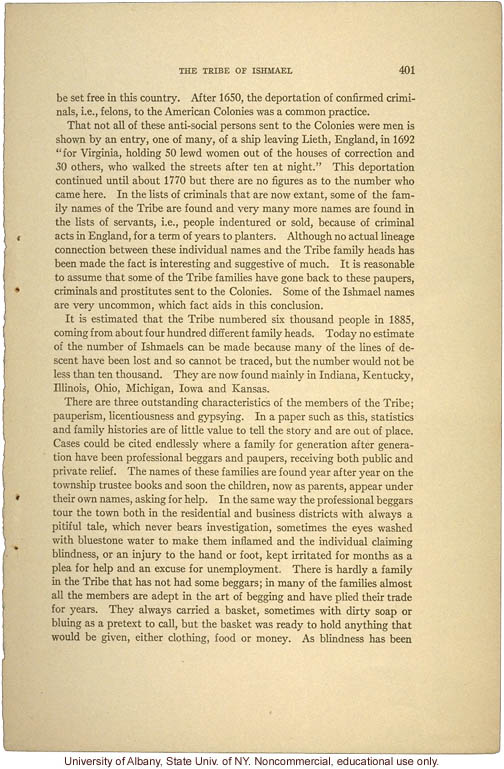The Tribe of Ishmael 401
be set free in this country. After 1650, the deportation of confirmed criminals, i.e., felons, to the American Colonies was a common practice.
That not all of these anti-social persons sent to the Colonies were men is shown by an entry, one of many, of a ship leaving Lieth, England, in 1692 "for Virginia, holding 50 lewd women out of the houses of correction and 30 others, who walked the streets after ten at night." This deportation continued until about 1770 but there are no figures as to the number who came here. In the lists of criminals that are now extant, some of the family names of the Tribe are found and very many more names are found in the lists of servants, i.e., people indentured or sold, because of criminal acts in England, for a term of years to planters. Although no actual lineage connection between these individual names and the Tribe family heads has been made the fact is interesting and suggestive of such. It is reasonable to assume that some of the Tribe families have gone back to these paupers, criminals and prostitutes sent to the Colonies. Some of the Ishmael names are very uncommon, which fact aids in this conclusion.
It is estimated that the Tribe numbered six thousand people in 1885, coming from about four hundred different family heads. Today no estimate of the number of Ishmaelites can be made because many of the lines of descent have been lost and so cannot be traced, but the number would not be less than ten thousand. They are now found mainly in Indiana, Kentucky, Illinois, Ohio, Michigan, Iowa and Kansas.
There are three outstanding characteristics of the members of the Tribe; pauperism, licentiousness, and gypsying. In a paper such as this, statistics and family histories are of little value to tell the story and are out of place. Cases could be cited endlessly where a family for generation after generation have been professional beggars and paupers, receiving both public and private relief. The names of the families are found year after year on the township trustee books and soon the children, now as parents, appear under their own names, asking for help. In the same way the professional beggars tour the town both in the residential and business districts with always a pitiful tale, which never bears investigation, sometimes the eyes washed with bluestone water to make them inflamed and the individual claiming blindness, or an injury to the hand or foot, kept irritated for months as a plea for help and an excuse for unemployment. There is hardly a family in the Tribe that has not had some beggars; in many of the families almost all the members are adept in the art of begging and have plied their trade for years. They always carried a basket, sometimes with dirty soap or bluing as a pretext to call, but the basket was ready to hold anything that would be given, either clothing, food or money. As blindness has been
[end]


